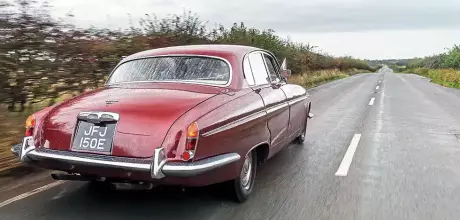1967 Jaguar 420G
Andrew Lobb has fond childhood memories of a Jaguar 420G. Today he rekindles them as we put him behind the wheel of one. ‘Ambience like a Bentley, at a fraction of the price’.
Words ANDREW NOAKES
Photography JONATHAN JACOB
After a childhood in the back seat, Andrew Lobb drives a Jaguar 420G
The List Andrew Lobb finally takes the wheel of his childhood-dream Jaguar 420G
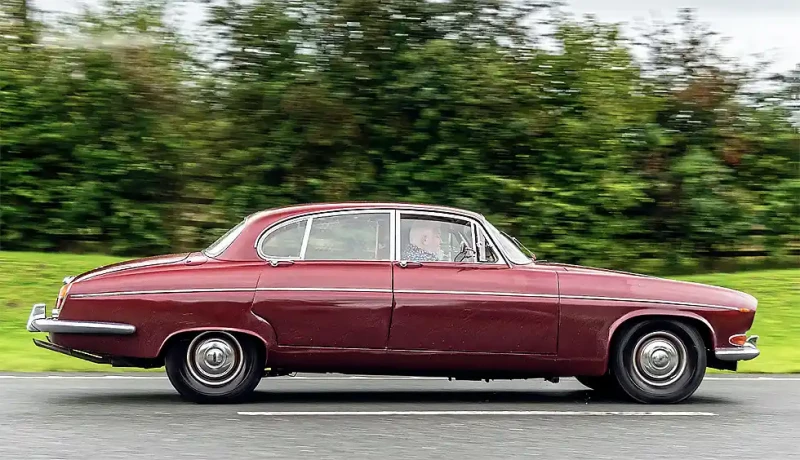
Andrew Lobb has never driven a Jaguar MkX or 420G himself, but he does have a strong personal connection to the big Sixties saloon. ‘My grandfather had one back in the day which I vividly remember riding in,’ he reveals. ‘It’s funny the details you recall from long ago. I can still remember the blue tinge to the glow of the instrument lighting at night.’ Today we’ve lined up a fine 420G so that, after all this time, Andrew can finally get to experience what they are like from the driver’s seat. Andrew’s dream car list is nothing if not eclectic. The machinery ranges from exotic GTs to sports cars to executive saloons. Cars from the Sixties like the Jaguar and the Rover P5B jostle for space with the Gilbern Invader from the Seventies, Audi Quattro from the Eighties and Lotus Esprit V8 from the Nineties. The values of the cars on Andrew’s list range from under £2000 to over £2m. It’s the Jaguar dream we’re making come true today, so we’re meeting 420G owner Tim Parsons at home in North Wales, just over the border from Cheshire.
‘You do need to press the accelerator hard. With three big throttles to open it’s really heavy’
Rain beads on the burgundy paintwork of Tim’s 420G as we take a look around it. When the original 3.8-litre MkX was announced in October 1961, six months after the E-type, it was the biggest Jaguar ever: just shy of 17ft long, a corpulent 6ft 4in wide and over two tons. If anything, as we survey the 420G in front of us it looks even bigger than those figures suggest, and Andrew quickly points out why. ‘The thing about these is they had 14in wheels,’ he says. That’s an inch less than the much smaller Jaguar Mk2, or the E-type, and two inches smaller than the rims on the Daimler Majestic Major which was a similarly substantial contemporary. The relatively small diameter of the wheels makes the whole car seem bigger in comparison. ‘They were made for the American market where all the cars had substantial bodies but small wheels. So the irony is it was the biggest car Jaguar had ever made, but with the smallest wheels.’
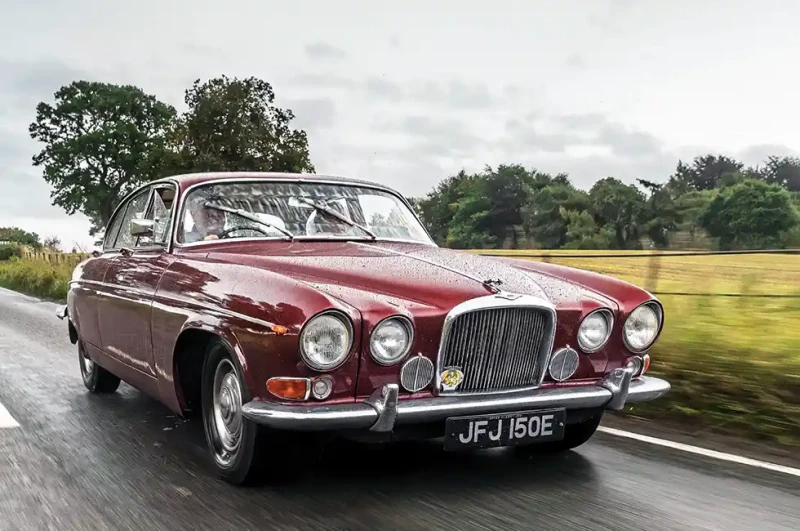
Walking around the 420G it’s clear that the shape, developed under the close supervision of Jaguar boss William Lyons, is extraordinarily cohesive. Every line seems to have a constructive relationship with every other, from the forward-leaning four-headlamp front end to the drooping tail. Yet the curves of the 420G are just slightly overdone, giving it the puffed-up appearance of an over-stuffed cushion. ‘The XJ6 that replaced it in 1968 certainly had a leaner, more elegant shape,’ Andrew says. ‘But Lyons wouldn’t have got there without this car bridging the gap from the upright shapes and blousy curves of the Fifties, represented by Jaguar saloons like the MkIX.’
Andrew is keen to look at the mechanicals so we tip the Jaguar’s vast bonnet forwards. It takes the grille and the inner pair of headlamps with it, giving pretty good access to the motor underneath. There’s the familiar sight of a 4.2-litre Jaguar XK straight-six engine, topped by ribbed black cam covers and fed by a trio of big SU carburettors. ‘This is the same engine that ultimately went into the E-type in 1964,’ says Andrew. ‘Jaguar also built a few thousand MkXs with the 4.2-litre engine, before the 420G proper arrived in 1966.’
Externally the clues to the saloon revamp were the chrome waistline trim flashes along the body sides, and a more prominent radiator grille with a thick vertical dividing strip. This example actually wears the simpler MkX-style grille, which Andrew and I agree is less fussy and suits it better.
The driver’s door opens with a satisfying click from the latch and Andrew swings the big door open with its chromed handle to reveal an interior swathed in cream leather and toffee-coloured veneer. ‘There’s no more than a nod to safety here,’ he says, pointing to the two vestigial black crash pads that flank an analogue Smiths clock on top of the dash. It still has the old-fashioned toggle switches which later Jaguars swapped for rockers. Rocker switches might be a bit safer in a crash but they don’t look nearly as good as these.’
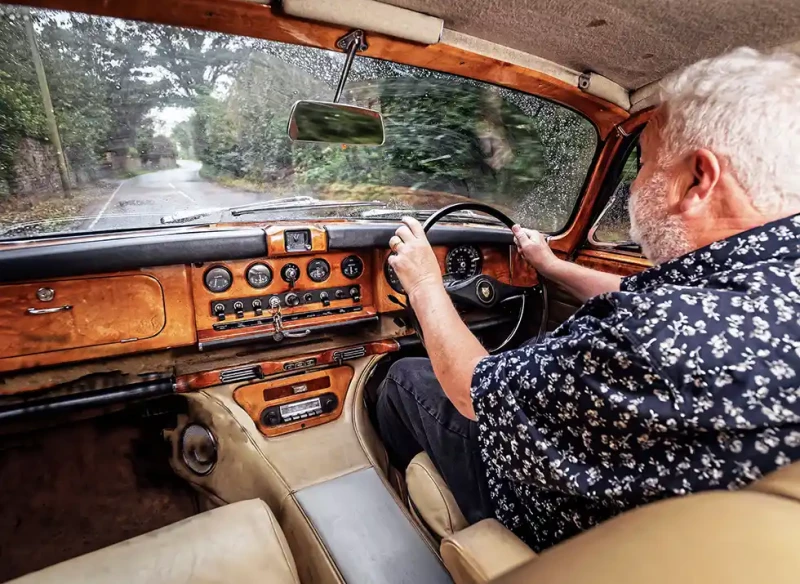
Andrew settles into the driver’s seat, a broad, flat pillow of soft leather, and grips the thin rim of the big steering wheel. ‘I’m over 6ft but there’s plenty of legroom and headroom here for me,’ he reports. There’s lots of space in the back, too, though the rear doors are smaller so entry and exit isn’t quite so effortless. The cabin is a big hit. ‘The veneered wood on the dash and doors is very handsome, and there are even fold-up picnic tables for the back-seat passengers. The ambience in here is almost like a Bentley,’ Andrew enthuses. ‘I’ll bet the Jaguar would have been a fraction of the price, because that was always the way William Lyons operated.’ He’s right: the cheapest Bentley in 1967, when this 420G was built, cost well over twice as much.
‘The dashboard is well stocked, with a rev counter, oilpressure gauge and an ammeter, plus a cigar lighter, a pull-out tray and sophisticated heating controls,’ Andrew says. ‘There are two fuel tanks, with a changeover switch here on the dashboard. I particularly like that when you turn the switch to swap tanks, the fuel gauge switches over to the other tank too. Everything is logically laid out and it all looks magnificent.’
It’s time to get the 420G out on the road, so Andrew slips the tiny ignition key into the dash and thumbs the starter button. The XK engine fires up with a characteristic clatter from the starter and idles with a gentle burble through the twin tailpipes. ‘It’s an auto transmission with a column-mounted shift lever, and there’s a clear indicator on top of the steering column with a pointer showing which range I’ve selected,’ says Andrew. ‘The pistol-grip handbrake is a bit of a stretch, though – it’s down by my left knee and quite hard to reach.’
‘The irony is it was the biggest car Jaguar had ever made, but with the smallest wheels’
It’s a few miles before Andrew feels completely comfortable driving the 420G. ‘It takes you a while to get into it,’ he says. The vast size of the Jaguar, particularly its width, is one factor and another is the solid, mechanical feel of a car of this age. ‘You’re getting out of a modern car which is easy to drive, and you’re getting into something that was designed back in the Fifties. Fortunately the finger-light steering makes life very easy for the driver. It’s a steering box with a variable ratio but you don’t really notice that on the move. It must cut down on wheel twirling when you’re parking as the steering gets more direct the further you turn away from the centre. The turning circle is apparently over 38ft, which is nothing to write home about, but the steering wheel only needs three turns from lock to lock and that actually makes the 420G feel quite wieldy for such a big car.’
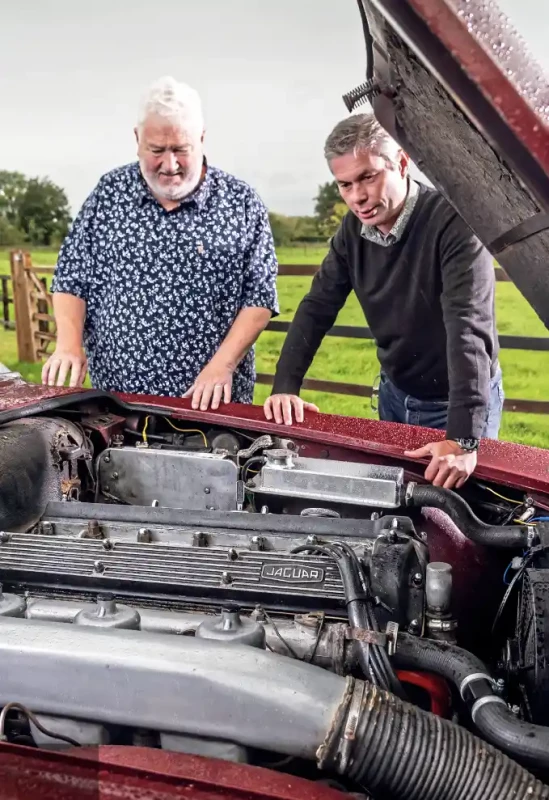
Automatic transmission, a three-speed Borg Warner Model 8, adds to the ease of driving. ‘Occasionally it will select a gear with a noticeable thump but most of the time it just slurs from one ratio to another almost imperceptibly,’ Andrew says. ‘You only really know it’s changed gear from the variation in the engine note. It pootles along quite happily in top gear at middling speeds – I’m not sure exactly what speeds because the speedo is a bit lethargic. Tim says a new one is on his shopping list! The engine is lovely – really smooth when it’s revving, fuss-free, very flexible and it has lots of mid-range torque. It has a wonderful, cultured engine note, too. It’s quieter than an E-type with the same engine but still just a little bit rorty – Tim says this car has a stainless steel exhaust and I suppose that might make it seem a bit louder than standard.’
The 420G was considered an impressive performer in its day, with 60mph coming up from rest in under 10 seconds and 100mph in about half a minute, with a top speed over 120mph. ‘If you give the accelerator a good shove the transmission changes down to its intermediate gear and the car surges forward,’ Andrew says. ‘It’s not really rapid by today’s standards, but it has enough performance to keep up with modern traffic without any problems. But you do need to press the accelerator quite a bit harder than you would on a modern car. With three big throttles to open, it’s really heavy.’
Andrew is getting on well with the 420G, but the relationship between throttle and brake pedals is troubling him a little. ‘The throttle pedal is quite a bit lower than the brake,’ he explains. ‘You’re pressing heavily on the throttle, and when you need to slow down you have to jump off that and it’s quite tricky to then get your foot up and across to the brake. You’ve got to think about driving it.’ The brakes themselves are excellent. ‘They can squeal when you use them gently, and when they do they squeal quite loudly,’ Andrew says. ‘Press harder on the pedal and they quieten down, and they’re very efficient – it has discs all round and they feel like they’d be more than up to the job of stopping two tons of Jaguar from well over 100mph.’

The 420G is proving to be a fine machine to cruise along in. ‘At speed on a main road the engine is quiet, and there isn’t much road or wind noise so you don’t have to raise your voice to have a conversation,’ Andrew says. ‘It feels stable at any speed. It’s not really at home on a winding country lane because it’s just too big, but it feels sure-footed on its Blockley radials.’
The 420G really shows its mettle when the road surface deteriorates. ‘It has all-independent suspension, with a rear end a lot like the E-type with a pair of springs and dampers on each side,’ Andrew says. ‘You really feel how good it is in the middle of a bumpy corner – it stays on line where lesser cars with cartsprung live axles would be darting about. This just feels solid and secure all the time, which inspires a great deal of confidence. The MkX and 420G are monocoques like the MkI and Mk2, just a lot bigger, and you can feel how stiff the structure is. There are no rattles or squeaks, however bad the road gets. The suspension does a superb job of ironing out all the bumps, leaving driver and passenger cosseted. It’s a very fine way to travel.’
According to Andrew the Jaguar 420G has more than justified its place on his dream drive list. ‘There’s an original brochure on the parcel shelf that claims the 420G had “every conceivable refinement” and it’s hard to dispute that. It’s easy to drive, well mannered and not nearly as daunting as the size might have you believe. I love the engine, it’s got a great induction noise, and the whole car has got a good feel to it. Lovely. It really does bring back some memories.’
Thanks to: Jaguar owner Tim Parsons and Stephen Wharfe of the Jaguar Drivers’ Club (jaguardriver.co.uk)
TECHNICAL DATA 1967 Jaguar 420G
- Engine 4235cc inline six, dohc, three SU HD8 caburettors
- Max Power 255bhp @ 5400rpm
- Max Torque 283lb ft @ 4000rpm
- Transmission Three-speed automatic with torque converter, rear-wheel drive
- Steering Marles Variomatic ‘hour glass’ cam and roller, power assistance
- Suspension Front: independent, double wishbones, coil springs, telescopic dampers. Rear: transverse links and fixed-length driveshafts, radius arms, twin coil springs, telescopic dampers
- Brakes Servo-assisted discs all round, inboard rear
- Performance Top speed: 122mph
- Acceleration 0-60mph: 9.9sec
- Weight 1883kg (4151lb)
- Fuel consumption 15mpg
- Cost new £2238 in 1967
- Classic Cars Price Guide £3000-£21,000
Six cylinders, three carbs, two cams, one very fine engine. Lunchtime on a rainy day? Stay in the car. Crash pads either side of clock mostly decorative.
Plump seats, slim steering wheel rim: it’s the Jaguar way


